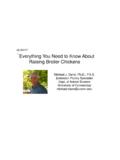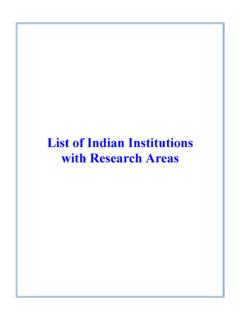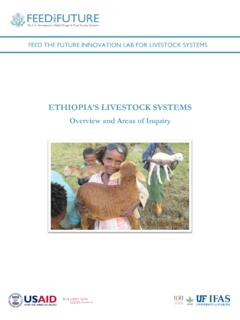Transcription of Incubating and Hatching Eggs
1 EPS-0017/13 Whether eggs come from a common chicken or an exotic bird, you must store and incu-bate them carefully for a successful hatch. Envi-ronmental conditions, handling, sanitation, and record keeping are all important factors when it comes to Incubating and Hatching egg qualityA fertile egg is alive; each egg contains living cells that can become a viable embryo and then a chick. Eggs are fragile and a successful hatch begins with undamaged eggs that are fresh, clean, and fertile. You can produce fertile eggs yourself or obtain them elsewhere. While commercial hatcheries produce quality eggs that are highly fertile, many do not ship small quantities. If you mail order eggs, be sure to pick them up promptly from your receiving area. Hatchability will decrease if eggs are handled poorly or get too hot or too cold in transit. If you produce the eggs on site, you must care for the breeding stock properly to ensure maximum fertility. Egg quality and embryo survival are influenced by hen and sire s: age health nutrition Factors that affect hatchabilityBreederHatcheryBreeder nutritionDiseaseMating activityEgg damageCorrect male and female body weightEgg sanitationEgg storageSanitationEgg storageEgg damageIncubation Management of setters and hatchersChick handlingCollecting and storing fertile eggsFertile eggs must be collected carefully and stored properly until they are incubated.
2 Keeping the eggs at proper storage temperatures keeps the embryo from starting and stopping development, which increases embryo mortality. Collecting eggs frequently and storing them properly delays embryo development until you are ready to incu-bate storage reminders Store less than 10 days Maintain temperature between 55 to 65 F Keep relative humidity at 75 percent Turn eggs stored more than a week Handle eggs with care!Cleaning and cullingDo not incubate eggs that are cracked, misshapen, soiled, or unusually small or large. These rarely hatch andcan potentially contaminate the good Incubating and Hatching EggsGregory S. Archer and A. Lee Cartwright** Assistant Professor and Extension poultry Specialist, Associate Professor and Extension poultry Specialist, The Texas A&M University System ratio genetics stress2eggs. Do not wash or wipe eggs with a damp cloth. Doing so can remove the egg s protective layer and allow disease and bacteria to enter.
3 It can also spread bacteria from one dirty egg to can gently buff soiled eggs with fine sand paper but this can also damage the egg s protective coating. It is best to avoid Incubating soiled eggs. General careOnce you have eggs to incubate, avoid damaging or contaminating them. Wash your hands fre-quently to remove bacteria from your timeEggs should be set as soon after you collect them as possible. Storing eggs for at least three days helps prepare them for incubation; however, fresh and stored eggs should not be set is best to incubate eggs within 7 to 10 days of their being laid. Hatchability decreases rapidly when eggs are stored for more than 10 days. After 7 days, hatchability decreases to percent per day. Each day in storage adds one hour to the incubation time. Temperature and humidity during storageFertile eggs should be stored between 55 and 65 F. If fertile eggs reach temperatures above 72 F, embryos will begin to develop abnormally, weaken, and die.
4 Embryos stored below 46 F also have high embryo mortality. Room temperature is generally too warm and the refrigerator is too cold for storing fertile eggs. If you plan to store eggs in a refrigerator, adjust it to an appropriate tempera-ture. Fertile eggs should be stored at 70 to 80 percent relative humidity. High humidity can cause con-densation to form on the eggshell. This can clog the pores on the eggshell and cause contamination the same way washing does. Clogging the pores can also suffocate the humidity during storage can make the egg lose internal moisture and kill the embryo. To increase the humidity, place a pan of water in the storage room. It is the surface area of the water influences humidity, not the depth of the water. Avoid drafts; these can dry the eggs out even when humidity is within the appropriate and turning eggs during storageIf you plan to store eggs for less than ten days before Incubating , place them on flats with the large end up.
5 You do not need to turn the eggs if they will be incubated within a week of being laid. You should cover the eggs with a loose material to keep them clean. If you plan to store eggs for more than 10 days, tilt them from side to side over a 90-degree angle once or twice daily. You can do this by placing a six-inch block under one end of the flat, switching the end of the flat each day until incubation. IncubationAn incubator is basically a box that holds eggs while maintaining an appropriate temperature, humidity, and oxygen level. Incubators have vary-ing capacities and adapters for eggs from different species. Popular incubator models often include automatic turners, humidifiers, and temperature controllers. Egg turners can usually be purchased separately for incubators that do not include them. Humidi-fiers can be the type that disperses water vapor as needed or many smaller incubators use a simple water reservoir. Temperature is controlled by older wafer systems or the newer digital thermostats.
6 Incubators come in forced air or still air versions. The temperature and humidity in a forced air incubator is more consistent. They also return to desired temperature and humidity more quickly after being opened. Still air incubators can give inaccurate humidity and temperature readings and the temperature in them can vary considerably. Whenever possible, use a forced air incubator. Regardless of incuba-tor type, for a successful hatch you must turn the 3eggs and monitor the temperature, humidity, and incubator should be in a room that has no drafts or direct sunlight; the temperature and humidity should be controlled and stable. The incubator and hatcher should also be isolated from the growing facilities. Newly hatched chicks can be contaminated by older birds and the dust created by growing birds. Take biosecurity mea-sures to insure the incubator area is not contami-nated by older birds. Chicks may be hatched in the incubator depend-ing on what type it is; however, Hatching creates large amounts of dust and down.
7 Hatching in a separate unit will keep dust and down from contaminating the incubator. Temperature and humidity can also be controlled more easily if you use separate units for Incubating and Hatching . Regardless of method, you must properly clean and disinfect the incubator and hatcher between to three days before incubationSanitize the incubator and run it for several days before setting the eggs. This will ensure that the incubator is maintaining the proper temperature and relative humidity before the eggs are set. Adjusting the temperature and humidity after the eggs are set can decrease hatchability. If you are using an automatic turner, test it completely before setting the eggs. The temperature and humidity of the incubation room should be correct and stable when you set the eggs. Do not set the eggs until the temperature and humidity in the incubators and the room are correct and and fumigationMicrobes in an incubator can significantly reduce hatchability.
8 Cleaning and disinfecting equipment must be standard operating procedures. Disinfect, incubators, hatchers and their racks with quater-nary ammonia or a commercial disinfectant after each day eggs are setLet stored eggs warm to room temperature for 4 hours to 8 hours before setting them in the incubator. If you place cold eggs in a warm, humid incubator, condensation will form on them and lead to possible contamination or suffocation. Once the eggs are in the incubator, do not adjust the temperature or humidity for a few hours, unless the temperature exceeds 102 F. After 4 hours, make proper adjustments. The final tem-perature should vary only .5 degree above or below F. The temperature of incubators with-out circulating fans fluctuates more than incuba-tors with circulating fans. If the temperature does not exceed 102 F, the hatch should not be harmed. Set the small end of the egg lower than the large end in the incubator. A developing embryo orients so that the head develops toward the air cell, which is in the large end of the egg.
9 If the small end is higher than the large end during incuba-tion, a chick s head can orient away from the air cell of the egg and not stageThe set stage refers to incubation period up until 2 or 3 days before a hatch. Different species have different incubation periods (Table 1). Incubating different species together in the same incubator is not recommended, especially if the incubator is also used as hatcher. Turning the eggs during incubation prevents embryo death and unhealthy hatches. Eggs must be turned at least five times every 24 hours. Turning more frequently is better and once per hour is best. Keep accurate records to ensure the eggs are turned three to five times each 24-hour period. Failure to turn eggs appropriately results in embryo death. Turning must continue even through weekends. An automatic turner simplifies this task and decreases human error during the incubation 1. Incubation period to hatch time and when to transfer to hatcher.
10 Temperature and humidity levels for common nameIncubation conditionsHatcher conditionsDaysTemperature FHumidity %RHTransfer dayTemperature FHumiditycanary13 14100. 556 5811996 6 75cockatiel18 6215 18996 6 74cockatoo22 6220 27996 6 74conure (sun) 6225996 6 74conure (various)21 6218 27996 6 75muscovy duck35 6231 6212996 6 74 Domestic 75geese (various)22 75grouse24 5822996 6 5822996 6 74lovebird22 6220 22996 6 74macaw26 6223 25996 6 74mynah14100. 556 5812996 6 74parakeet18 6215 23996 6 6215996 6 74parrot (various)18 6215 25996 6 74parrot (african grey) 6225996 6 74chukar partridge23 6 74peafowl28 6225 75ptarmigan21 6218 20996 6 74raven20 6217 18996 6 74ring-neck pheasant24 6221996 6 74pheasant22 6220 25996 6 74pigeon17 19100. 55814996 6 74bobwhite 5821996 6 74japanese quail17 6215996 6 74swan33 6230 33996 6 75emu49 509 7. 532 40479 7.






